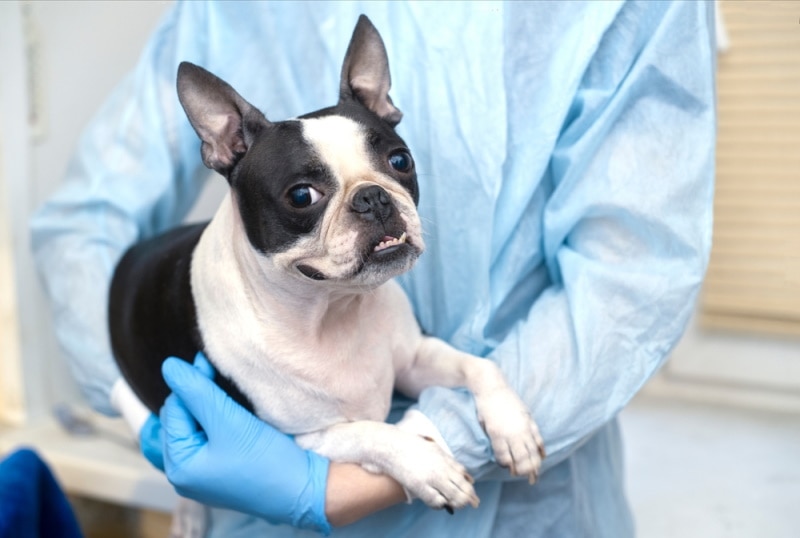How to Pick Up a Dog: 6 Vet Approved Steps
Updated on

It’s essential to get your pup accustomed to being handled. That includes touching your dog’s paws and ears, and opening their mouths. It also involves picking your pet up, whether it’s to get into the car or a carrier. Your vet will appreciate your efforts in making exams and routine care more manageable. You should begin while your pup is young because they’re smaller and easier to hold. Also, always make it a positive experience when possible.
Remember that canines are more fragile than you may think. Their limbs move in different ways. Picking them up isn’t natural for adults, making approaching them carefully vital for avoiding injury to you or your pet.
Before You Begin
Cats and dogs carry their young around by the scruff of their necks, but that isn’t something you should do. How you approach picking up your pet depends on their size. Of course, it’s easier with a smaller animal than with a larger one, and judgment should be used when deciding when a dog is or isn’t pickupable.
We suggest minimizing distractions in the place where you’re going to pick up your pet. The focus should be on you and the task at hand. If you’re working with someone else’s pup, ask their permission before you approach the animal. Be aware that a pet that is injured or in pain is most likely to bite, and picking up the dog incorrectly could further complicate matters.
We recommend putting a collar on the pup if one isn’t already present. It’ll give you an extra handhold if needed. Likewise, you may find it helpful to have a leash handy. If necessary, you should muzzle the dog for both of your safety, but hopefully, this isn’t necessary.
The 6 Steps on How to Pick Up A Dog
1. Make the Dog Feel Comfortable
It’s essential to make the dog comfortable, no matter if it’s your pet or an unfamiliar animal. Speak softly to the pet while getting down to their level. We recommend letting the dog come to you instead of vice versa. A pet that is comfortable around people will likely approach you. If you must make the first move, make sure the pup knows you’re doing so. It is useful to use a word or gesture to communicate your intent to pick them up, like “up!” or “up we go” or whatever works for you. That way, you can always let your dog know what’s going to happen next and they aren’t caught off guard.

2. Squat Near the Pup to Get a Good Hold of the Animal
Getting closer to the floor can help prevent injuries if the dog backs off or bolts. Continue talking softly to the animal to reassure them you’re not a threat. Don’t rush the process if the pup seems uncomfortable or uncertain.
3. Go Under the Chest and Around the Bum
Position yourself and the dog so that their head is facing toward your non-dominant arm. Slowly reach that arm behind the front legs and under their chest, resting the palm of your hand against their chest. At the same time, reach your dominant arm over the hindquarters behind the tail, and scoop their bottom into the crook of your elbow, with your hand gently holding the back leg closest to your body.

4. Hold Them Tight…But Not Too Tight
Pull them firmly against your body. The more they can wriggle, the less secure they will feel, so make sure you have them held securely against you, but not so tight that they can’t breathe!
5. Stand Up With the Dog in Your Arms
As you stand, talk to the pup gently and calmly. Remember that if you feel confident and calm, so will they. Don’t relax once you’ve stood up in case your pup makes a last dash for freedom. Have a little walk with more soothing words until you are satisfied that they are comfortable in your arms.

6. Release Your Pet With a Treat
Putting them back down again probably sounds easy, but this is the part where a lot of pups wriggle free and tumble to the ground, so don’t forget to keep holding them tightly until you’re back down at ground level. Release your pup with lots of praise and a treat. Doing this a few times will mean that being picked up will be seen as a positive experience, not a scary one.
Tips to Avoid Being Bitten
Reading a dog’s body language is vital to avoiding being bitten. A sick or injured animal is more likely to bite, especially if being picked up worsens their pain. Some dogs might be aggressive as a knee-jerk reaction to feeling startled or threatened, so it is important to communicate with any dog if you are going to pick them up, whether it be using your pre-established word, or just talking to the dog calmly so they know you are there.
Most dog bites occur with familiar animals, with children and seniors more often the ones bitten. Small children must be taught to not try to pick up your pup, as this is the sort of scenario that can end badly.
Equally, exposing your pup to lots of different experiences, scenarios, and sounds will make them much more adaptable, confident, and less easily spooked.
Final Thoughts
Although some dogs are far too large to pick up on your own, there are plenty of situations where you may need to scoop up your smaller puppy or dog. If you follow the steps above, and focus on making it a positive experience for you both, you and your dog will feel confident the next time.
Featured Image Credit: Zakharova_Elena, Shutterstock













